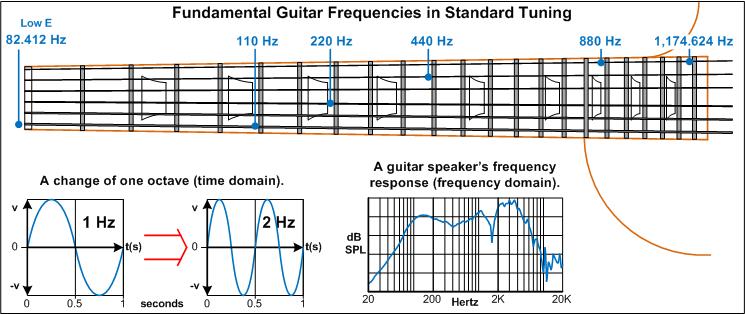As guitarists, most of us sooner or later find ourselves in pursuit of tone. A talented guitarist can find a way to make anything sound good, but there should be no doubt that our equipment and the tone it provides can inspire and help fuel our creativity. In pursuit of tonal inspiration, we need to develop a vocabulary to help us find what we’re looking for in our sound.
The Audible Frequency Range
Most guitarists start out by learning the names of the musical notes corresponding to a particular string and fret number, but they are not initially aware that these notes also correspond to the fundamental frequency of the vibrating string. For example, the sixth string played at the 5th fret (low A) in standard tuning has a fundamental frequency of 110 Hz. Any doubling or halving of a frequency is an octave, so the next octave up from 110 Hz would be 220 Hz. In order to develop a vocabulary for tone, we have to think in terms of frequencies as opposed to musical notes.
The audible frequency range for us human beings is about 20 Hz to 20,000 Hz (20 kHz). For descriptive purposes, it’s common to divide this range into at least three parts: lows, mids and highs. The specific border frequencies where, for example, lows end and mids begin are not definite. Look at a guitar speaker’s frequency response chart and you’ll see three commonly accepted ranges: lows from 20 to 200 Hz, mids from 200 Hz to 2 kHz and highs from 2 kHz to 20 kHz. With respect to these divisions, the fundamental guitar frequencies are all low to mid range; however, the sound we hear from each note we play also consists of harmonic frequencies in addition to the fundamental. To get an idea of what the fundamental would sound like on its own, just play a note and turn the guitar’s tone control all the way down. You’ve just “rolled-off the highs.”
If you play through an amp with treble, middle and bass controls, you can experiment with the extremes of each control setting to get a feel for how the relative level of each frequency range shapes the overall sound. “Scoop the mids” by turning the middle control down. “Roll-off the lows” and “thin-out” the tone by turning down the bass control. Now, “Fatten-up” the tone by turning the bass control back up.
Describing Tone
Using words to describe how something sounds is not always easy, but in the pursuit of tone it is often necessary. Browse through websites and ads for guitars, pickups, effects, amps, tubes, speakers, etc. and you’ll see a plethora of tonal verbiage that would probably seem like nonsense to the non-musician. When reading through this jargon, you can usually separate the adjectives into at least two groups to get a better perspective of the big picture.
First, there are the basic tonal adjectives that stand on their own. Most guitarists would understand their meaning without the need for much clarification. The words in this group stand on their own because they are closely related to common control settings. Describing tone is simplified considerably when a comparison can be made and most of the adjectives in this group can be paired with a clear opposite. For example, you might compare bright vs. dark for highs, full vs. scooped for mids, fat vs. thin for lows or some other variation to express more or less of a particular attribute. You could say, ‘I’m using Acme brand 12AX7 tubes in my amp and they sound too muddy, I need something that will brighten up the highs and give me more gain.’
Second, there are the ambiguous adjectives that leave you with some doubt as to what they really mean. They serve as a kind of garnish to add personality and make a tonal description sound more appealing or marketable. For example, the highs might be crisp or bell like with sparkle or chime, the mids might be buttery or woody, there might be mid-range honk, the tone could be warm, rich or creamy. This is good stuff if you don’t take it too seriously, but these words don’t really mean much on their own. If someone told you that a particular speaker sounds ‘rich and creamy with buttery mids and crisp highs, ’ they might as well have said, ‘it sounds great, trust me.’ Another aspect of this group of adjectives is that they can allow you to identify a target audience that the product was designed to reach. For example, you probably wouldn’t target the death metal crowd with a ‘warm, vintage-voiced pickup with rich fat lows and top-end sparkle to express the subtleties of your playing style in fine detail.’ You’d be more likely to describe ‘fat, thunderous lows with upper mid-range sizzle and crisp highs for brutal rhythm and scorching leads.’
When communicating with other people to get suggestions for which product might get you closer to the sound you’re looking for, it’s usually best to make comparisons, while using mostly adjectives from the first group and going light on those from the second. Of course, the best way to know if something is right for your sound is to play through it yourself and set up an A/B comparison, but that’s just not always possible. So as we journey along in our pursuit of tone, we have to develop a vocabulary to help ourselves and others find the way.
Kurt Prange (BSEE) is the Sales Engineer for Amplified Parts (www.amplifiedparts.com & www.amplifiedmusician.com/) in Tempe, Arizona, United States. Kurt began playing guitar at the age of nine in Kalamazoo, Michigan. He is a guitar DIY’er and tube amp designer who enjoys helping other musicians along in the endless pursuit of tone.


